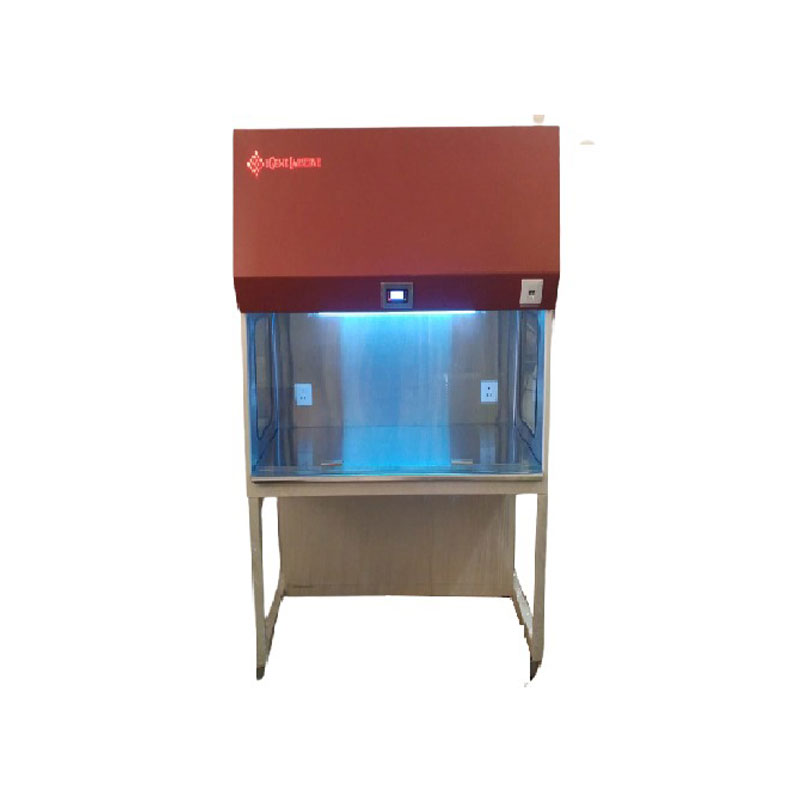Laminar air flow is referred to as a system that provides continuous air flow that is uniform in both direction and velocity. Laminar air flow cabinets facilitate unidirectional air flow in a confined space. They create the particulate-free working area by emitting air through a filtration system and exhausting it across the work surface.
Concept of a Laminar Air Flow Cabinet
They are enclosures designed to flow HEPA-filtered air with uniform velocity and direction. Due to this unidirectional airflow, a sterile environment is maintained while preventing cross-contamination.
Types of laminar airflow cabinets
Given below are the two types of laminar hoods based on the direction of the airflow:
- Vertical laminar airflow: Being the more common type, here the air flows from top to bottom. The blower and the filters are staged on top of the device. From the enclosure’s front, the air flows out after hitting the work surface.
- Horizontal laminar airflow: This airflow type is rather spacious and large. It mounts the HEPA filter at the back of the cabinet. Generally, the airflow is from back to front and can’t function if the front glass sash isn’t opened. The pre-filter is located with the front wall of the box beneath the work surface and sucks air from the front. On the other hand, the blower is located at the bottom portion.
How they are made?
Generally, laminar air flow cabinets are made up of stainless steel without any joints or gaps. Since there is no gap, the entry and gathering of the contaminants are easily prevented.
Why should you use laminar air flow cabinets?
Researchers in bioscience labs work with sensitive things floating in the air. A small volume of air can have millions of microbes in it. Will you want that in your precious culture? No. If you have to keep your operation safe from these airborne contaminants, you need to work in a sterile and filtered air environment.
Also, the airflow has to be laminar in nature. Normally, air flows in uneven patterns. Turbulent air flow generates lots of eddies and vortices that disrupt the sterile-air environment. Normal air flow gathers and deposits particles from outside air on your hard-worked culture and misinterprets the entire result. Hence, the work area in the air moves as a single body in uniform velocity and direction. This won’t lead to the formation of eddies and vortices.
How does a Laminar Airflow Cabinet Function?
The main objective of a laminar air flow cabinet is to provide a sterile and filtered air environment. To perform this function, it uses the listed parts:
- Work surface
- Enclosure
- Blower/fan
- Prefilter/filter pad
- HEPA filter
- UV lamp
These parts work together to construct a laminar air flow cabinet. The blower helps the device to suck in room air from the top or front of the device. The air goes through the filter pad that collects large dust particles from the air. Thereafter, the air passes through the HEPA filter which filters out the microbes and other particles. The filtered air touches the enclosure and washes over the work surface. It clears every type of suspended microbes and particles.
To sterilize the work area, you have the option to use the UV lamp to sterilize the work area. The device is constructed carefully so that the air flow is kept laminar. All portions of the enclosed air flow in straight lines parallel to one another in the same direction. The airflow type can be vertical or horizontal in a manner based on the purpose of the sterile hood. It will keep both the sample and the user safe in absolute terms.

Parts of a Laminar Air Flow Cabinet
A laminar air flow cabinet has several parts as listed below:
- Enclosure: It is a box that provides the voluminous area to function as a sterile environment. This device comprises a stainless steel cuboid box with a glass shutter. The sterile environment created inside the cabinet is protected by the enclosure. It is this enclosure that separates it from the outside environment.
- Work surface: The work surface is also made of stainless steel. It’s the flat table for you to operate on inside the enclosure. When it comes to a vertical laminar air flow, the work surface may have perforations in it to let the air pass through.
- Filter pad: A filter pad is positioned on the top of the cabinet through which the air flows into the cabinet. This filter pad traps microbes and dust particles from entering the working space within the cabinet.
- Fan or Blower: It is the actual machine responsible for the airflow. The fan sucks the air in through the pre-filter and presses it through the HEPA filter. The machine sits in between these filter pads and manages the airflow. It can come in different sizes based on your model. It may also have different powers. While running, it makes a fair amount of noise.
- HEPA filter: It is the most critical part of a laminar air flow The HEPA filter is positioned next to the Enclosure separated by a mesh. When the device is horizontal airflow type, the HEPA filter will be at the back of the cabinet. If the airflow type is vertical, it will be placed on top of the enclosure.
- UV lamp: It’s true that HEPA filter supplies well-filtered air, but it isn’t completely sterile. Only certain microns get passed through the filter and some external air does get in somehow. The enclosure surfaces and work area can have microbes with them. The UV lamp radiates ultraviolet light which cleans them out.
Advantages and Disadvantages of a Laminar Airflow Cabinet
Let’s explore the advantages and disadvantages of a laminar air flow cabinet:
Advantages
- Sustainable— doesn’t release toxic gas into the environment
- Easy to maintain— when the pre-filter gets dirty, all that you need is to wash the same.
- Portable: 90% of laminar air flow cabinets are lightweight and comprise castor wheels on the bottom. With these wheels, you can easily reposition them.
- They provide a sterile atmosphere in which you can do the research work.
- Cheaper— a laminar air flow cabinet is cheaper than most other machines.
Disadvantages
- When you work while the flow is turned on, it generates disruptive air columns with vortices and eddies.
- A horizontal air flow cabinet blow contaminated air directly at the face of the user.
- These machines fail fast if they aren’t handled properly.
What are the dos and don’ts of Laminar Airflow?
- Wear long protective gloves, safety glasses, and lab coats while you operate a laminar workflow cabinet.
- Don’t use the UV light and airflow functions at the same time.
- Always remember to sterilize all apparatus and components inside the machine before and after use.
- Don’t keep any body part inside or close to the laminar air flow cabinet with the UV light turned on.
- You should always irradiate everything inside the safety hood with the UV lamp both before and after use.
- Don’t turn on the UV light while a process is happening in the cabinet.
The bottom line
A laminar air flow cabinet is a useful instrument when you need to do sensitive work. It provides a clean atmosphere inside the cabinet, thereby, enabling you to work with sensitive components like electronic wafers and tissue culture. Besides being cheap and portable, air flow cabinets are a sustainable option and are light in weight. However, you should always wear protective lab clothing while operating the hood. At the same time, you also need to adhere to the operating manual. Moreover, you should be careful while buying a laminar air flow cabinet. Assess your requirements before choosing a type.
Are you looking for a high-quality laminar air flow cabinet to conduct your research experiments? If you feel so, you are on the right track with www.igenels.com. Here, you get a myriad of choices that will cater to your requirements at large.

